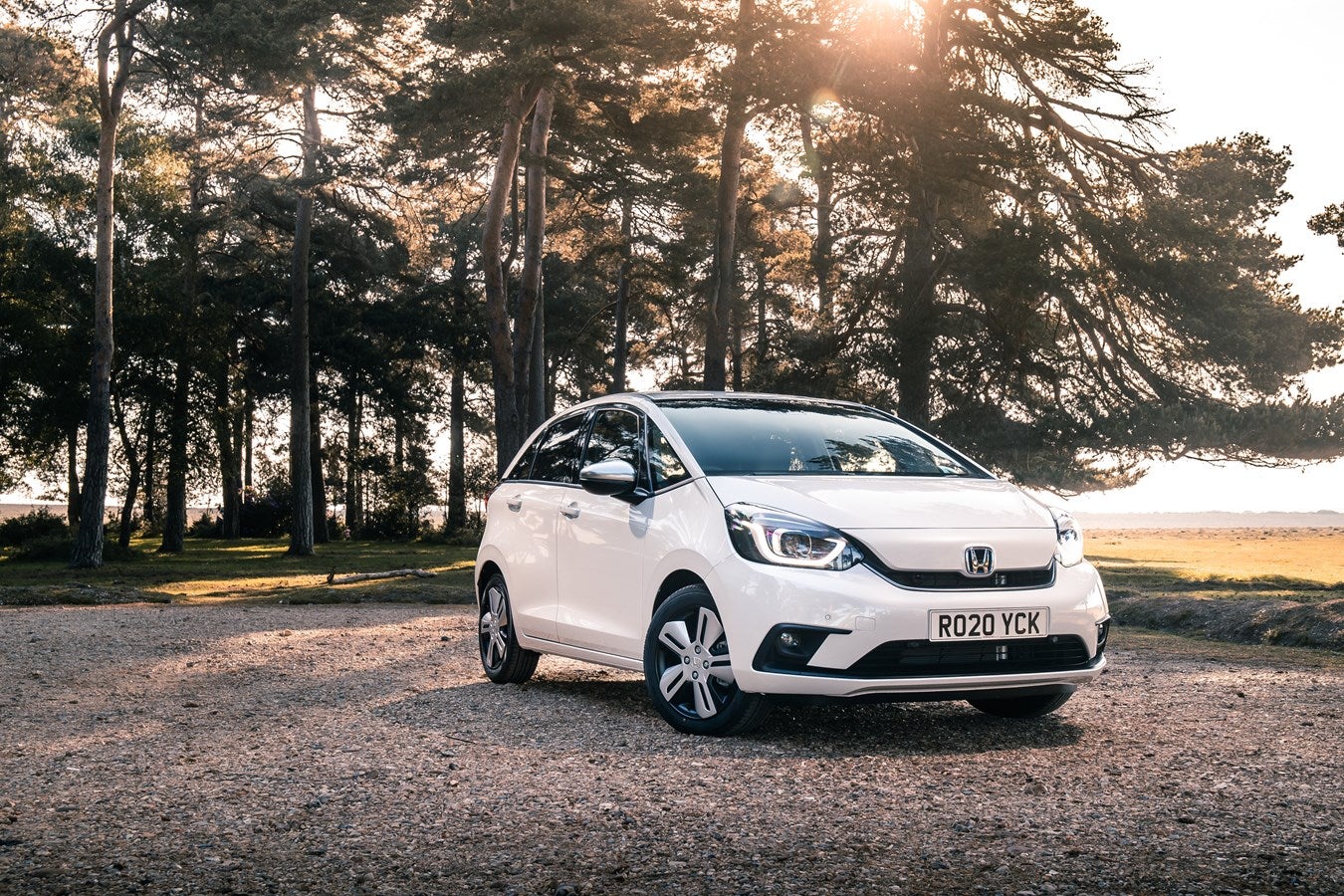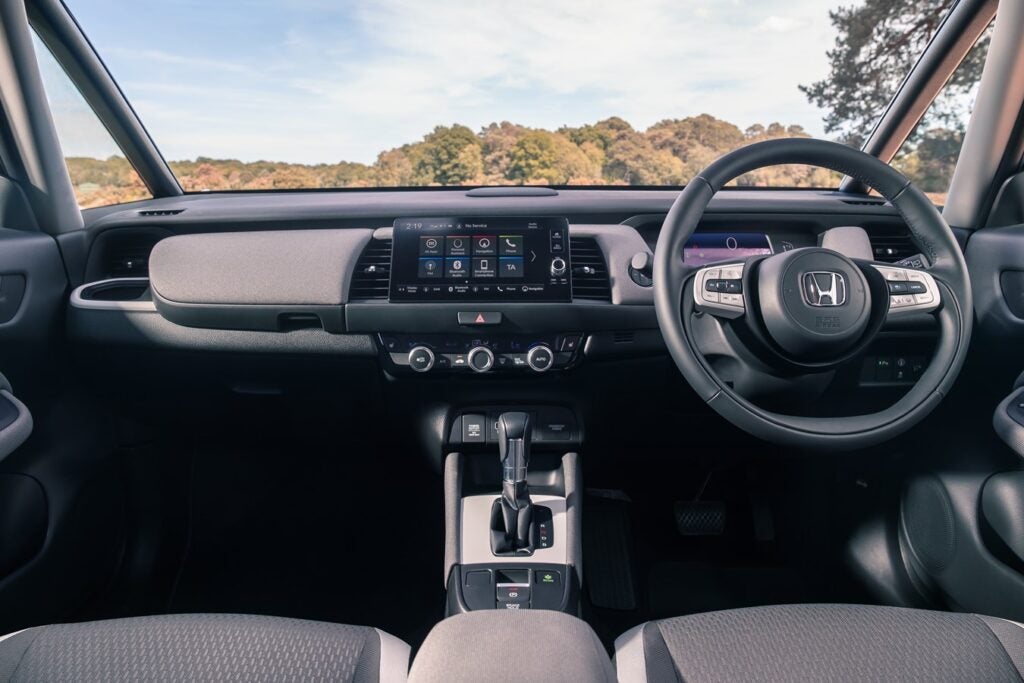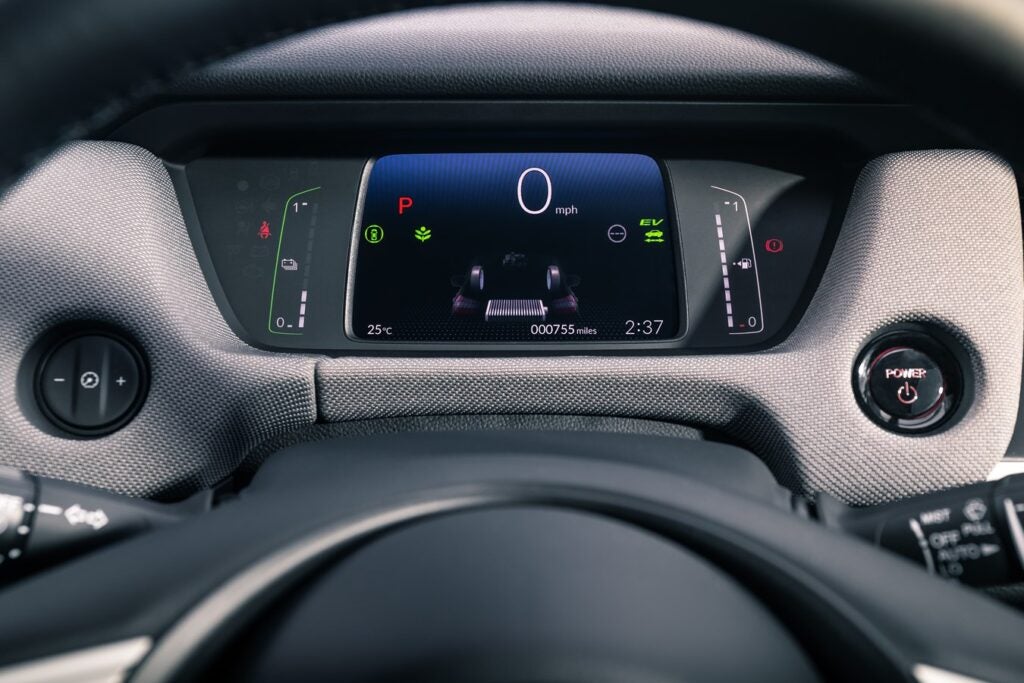
Inside story
The latest generation Jazz, also known as ‘Fit’ in some markets, has even more space and technology than its predecessor. Honda’s ‘magic’ seats fold and collapse into a range of configurations for carrying passengers and stuff. We have seen this same arrangement on other Honda models for quite a while but it’s still impressive. The luggage capacity (with rear seats up) starts from 298 litres and increases to 1,199 litres (to the roof with the rear seats down). This is partly thanks to the packaging of hybrid drivetrain components into the chassis and within the engine bay.
Also key to maximising cabin room is the positioning of the fuel tank in the centre of the chassis beneath the front seats, which is a first in this class. The packaging and overall design also permit a wider tailgate opening and a new stepless flat floor that makes loading and unloading the boot easier.
Front seat occupants benefit from Honda’s newly developed body stabilising seat frame with mat-structure support and a 30mm seat padding thickness increase. These changes enhance comfort levels and provide greater lumbar support to minimise fatigue.
To further increase driver comfort, the position of the brake pedal has been changed to optimise the foot angle offering a more natural foot placement. In addition, to support taller drivers, the quirky two-spoke leather steering wheel is now two degrees more upright and the range of adjustment has been revised to allow the wheel to be positioned closer to the driver. All in all, it makes for a pleasant place to sit.
Forward visibility is good, partly because the A-pillar thickness has been more than halved from 116mm to 55mm with the rear pillar now providing the main structural strength. This, along with the hidden windscreen wipers and deep, flat dashboard. provide the driver and front seat passenger with a good field of vision. The sweeping A-pillars and door-mirror design minimise noise and drag caused by wind turbulence. The highly raked windscreen and front quarter glass allow more natural light to flow into the cabin resulting in a greater sense of space for occupants.

US Tariffs are shifting - will you react or anticipate?
Don’t let policy changes catch you off guard. Stay proactive with real-time data and expert analysis.
By GlobalData
Connectivity and infotainment
Connected infotainment features and apps can be accessed via touchscreen or voice activation, including weather, parking locations, music, navigation, location finding, and phone services.
The LCD touchscreen interface is designed to minimise driver distraction; operation time for the most regularly-used controls is reduced by 58% compared with the previous model. The nine-inch touchscreen allows you to pinch, swipe and tap through the Honda Connect in-car audio and information system. This includes DAB and internet radio (with a welcome dial to control the volume rather than a touch-slider), phone interface and Bluetooth connectivity, and a rearview parking camera with dynamic guidelines.
Beneath the touchscreen is a no-nonsense cluster to operate the HVAC with chunky dials and buttons. Plenty of storage spaces and cubby holes are dotted around the cabin, including a useful pair of glove boxes.
The suite of apps can be supplemented by smartphone mirroring, enabled by Android Auto and Apple CarPlay, with the latter available via wireless connection for the first time in the Jazz. Even the owner’s manual can be accessed via the onboard touch infotainment system or through AI voice control for customers who have subscribed to Honda Personal Assistant.
My Honda+ app provides secure access to a range of in-car functions, including convenience and security features. For example, journey information can be set up and sent from the app to the car and it can also lock and unlock the car remotely.
For additional security, the app provides location monitoring and car tracking via GPS. Intelligent Geofencing can also be activated to alert the owner if the vehicle breaches a pre-set ‘geofence’ zone, plus a security notification delivered to the smartphone app if the car’s security alarm is activated.
The Honda Personal Assistant assesses command inputs with a level of complexity beyond the capabilities of other voice-activated virtual assistants. The system understands several levels of interaction, for more exact responses to specific queries. An owner can ask, for example: “OK Honda, find me an Italian restaurant with free parking, WiFi, and that’s open now.”
All vehicles feature E-Call for roadside assistance as standard. In the event of an emergency, such as airbag deployment, the car’s location is automatically shared with the relevant emergency services.

Advanced driver assistance systems
Every Jazz comes with a number of advanced driver assistance system (ADAS) technologies, including city-brake active (to help avoid low-speed accidents), forward collision warning (detects the risk of collision by recognising the vehicle ahead, using a camera), traffic sign recognition system, intelligent speed limiter (combines two otherwise independent safety systems – adjustable speed limiter and traffic sign recognition system), lane departure warning (increasingly common across the segment) and high-beam support system (which is surprisingly quick at adjusting the headlight beam).
A new wider angle, higher definition camera replaces the multi-purpose camera and City-Brake Active System sensor set-up of the previous-generation Jazz. The camera recognises a range of road surfaces and traffic characteristics. These include detecting if the car approaches the outer edge of pavement (into a grass or gravel border), an oncoming vehicle, or drifting into another lane without indicating, and road signs. The camera is also able to eliminate condensation for a constantly clear field of view.
On the road
The Jazz is fairly quiet on the road. More insulation and sound deadening material has been fitted to reduce road noise from road surface variations, improving cabin ambience in three frequency ranges. The cabin and floor panel are separated to reduce resonance through the car’s structure, and sound insulation has been added around the dashboard. Noise from the engine has also been reduced through the use of resin material to the engine mount to insulate the engine bay. The sound-absorbing materials and thicker glass contribute to a 10 per cent reduction in noise intrusion to the cabin over the previous Jazz model.
The latest generation Jazz is the first model to be presented under Honda’s new e:Technology branding. It consists of two electric motors connected to a 1.5-litre DOHC i-VTEC petrol engine, a lithium-ion battery and a fixed-gear transmission via an intelligent power control unit. The total output of 109PS can propel the car to 62mph in just over nine seconds. While our road test didn’t match Honda’s headline fuel economy of 62.8 mpg, we weren’t far off at 58 mpg. All in all, the latest variant still feels just as spacious, practical and comfortable, even on long journeys, once you get into it. Rival models include the Ford Fiesta, Hyundai i20 and Peugeot 208 to name a few.



